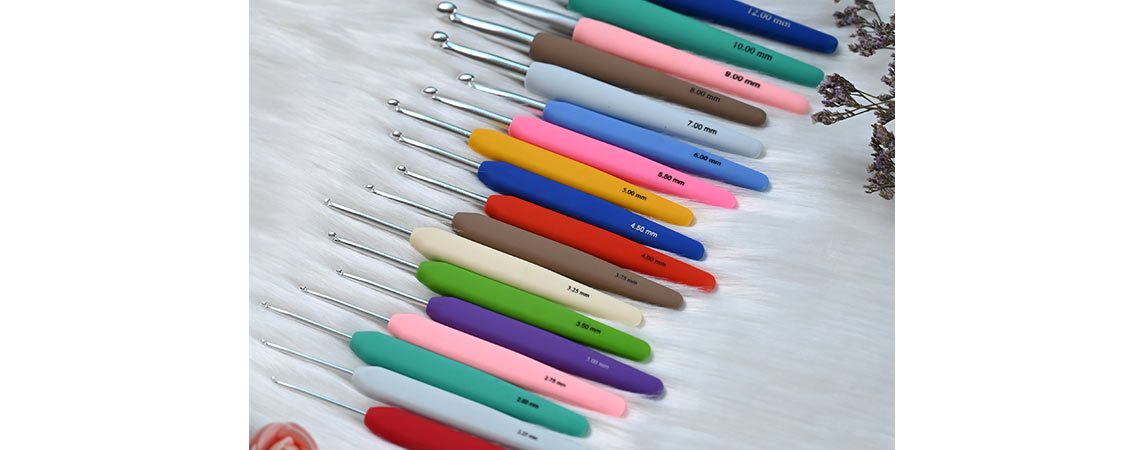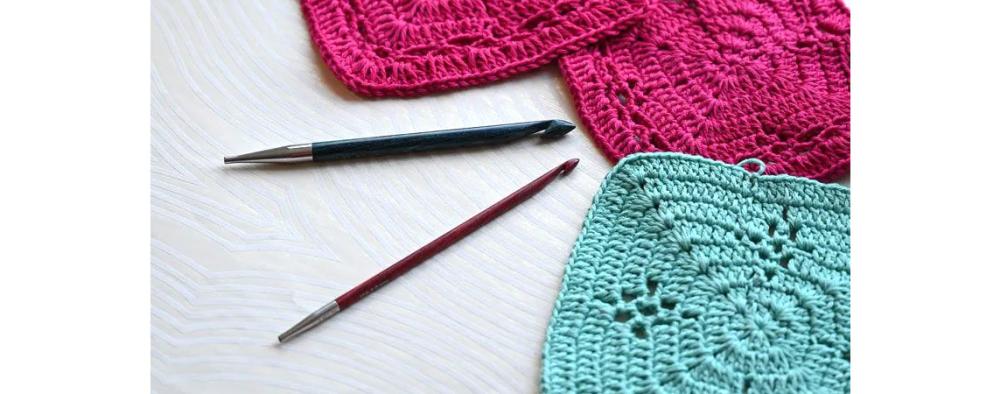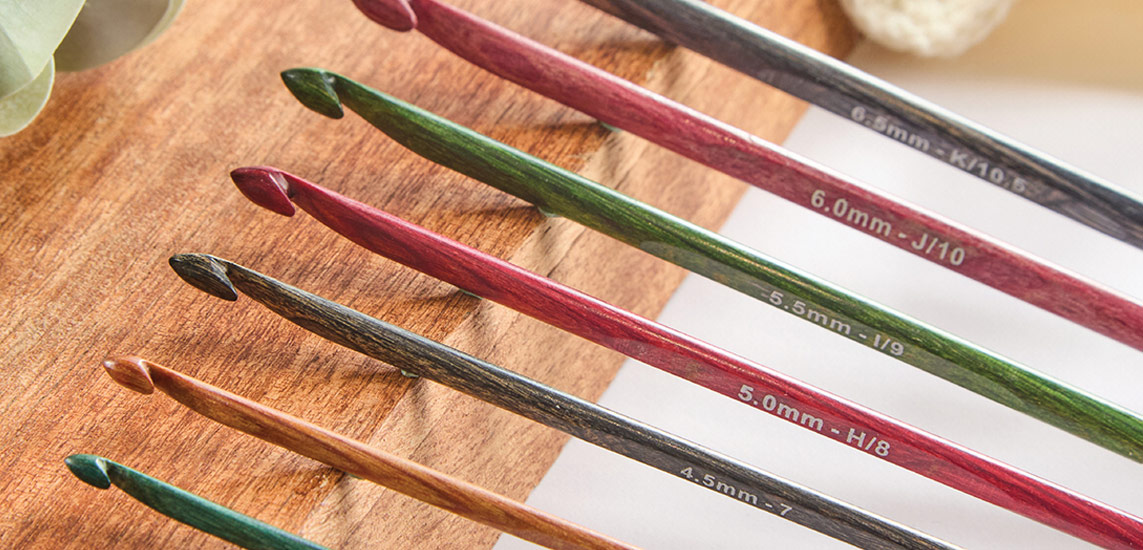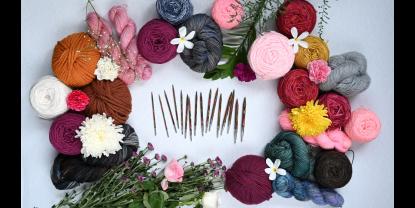Are you unsure whether to learn to crochet with a regular, single-ended hook or a Tunisian crochet hook? Both crafts became hugely popular in the 19th century. Queen Victoria used to crochet with a Tunisian or Afghan crochet hook, and the term ‘Royal Princess Knitting’ was born. Until today, Tunisian crochet continues to be confused with knitting. But one thing is clear: Tunisian and single-ended crochet are two stand-alone fiber crafts with unique but distinct looks and stitches.
In this post, we'll explore the advantages and challenges of single ended and Tunisian crochet, helping you choose the right technique for your next project. Whether you are eager to tackle new challenges or are a complete newbie to crochet, this guide will clear the path for your crafting future.
Single Ended Crochet

The first visible difference between Tunisian crochet and its single ended cousin is the tool. In regular crochet, you typically use a traditional crochet hook, which is shorter and has no cord and stopper at the end like the Tunisian crochet hook.
In single ended crochet, stitches are worked one at a time and not held on the hook. Each stitch is completed before moving on to the next. The work is turned at the end of rows or worked in the round without turning for circular projects. This method creates a more open and flexible fabric compared to Tunisian crochet. The fabric created with single-ended crochet can vary widely from lacey and open to dense and warm, depending on the stitches used.
Single ended crochet is extremely versatile; with a few basic stitches like single, double or treble crochets, you can “turn strings into things”, as the saying goes: From garments, accessories, and toys to home decor, your crochet hook is the gateway to creating airy lace fabric to sturdy bags and baskets.
Tunisian Crochet

Tunisian crochet requires a special type of crochet hook, which is longer than a traditional hook and can have a cord and stopper at the end to prevent stitches from slipping off. There are double ended Tunisian hooks, too for working in the round.
Unlike traditional crochet, Tunisian crochet involves keeping multiple stitches on the hook, similar to knitting. Each row is worked in two parts: the forward pass, where stitches are picked up and kept on the hook, and the return pass, where stitches are worked off the hook. Although there are some similarities with regular crochet, Tunisian crochet has its own set of unique stitches, such as Tunisian simple stitch (TSS), Tunisian knit stitch (TKS), and Tunisian purl stitch (TPS).
The resulting fabric is typically thicker and denser, with a unique woven-like appearance that resembles knit stitches. Tunisian crochet is ideal for projects like blankets, scarves, and wraps and warm garments like sweaters or pants.
What is Easier to learn - Tunisian or Single Ended Crochet?
The ease of learning Tunisian crochet versus traditional crochet can vary greatly depending on the individual learner's preferences, dexterity, and familiarity with yarn crafts.
Single-Ended Crochet:
- Single-ended crochet is often considered more accessible for beginners. The basic stitches, such as the chain stitch, single crochet, and double crochet, are simple to learn and form the foundation for more complex patterns. Many people find these basic stitches intuitive after a little practice.
- Using a single, shorter crochet hook working only one loop at a time might be easier for beginners, making the manipulation of yarn and the creation of stitches less cumbersome.
- Single-ended crochet can be more forgiving with mistakes. It's generally easier to unravel work (frogging) and correct errors, which can be less frustrating for those new to yarn crafts.
Tunisian Crochet:
- Tunisian crochet comes with a mesmerizing technique of holding multiple stitches on the hook and working in two passes. It may be more complex for absolute beginners and combines elements of both knitting and crochet,
- The longer Tunisian crochet hook or cable hooks used for larger projects may be more difficult for beginners to manage initially.
- The fabric created with Tunisian crochet is denser and has a different, unique look, great for all crafters who like to create and wear outstanding items.
In short: Tunisian vs. Single Ended Crochet
|
Feature |
Tunisian Crochet |
Single-Ended Crochet |
|
Tools |
Long hooks with or without a stopper; cable hooks for larger projects. |
Traditional shorter hooks. |
|
Technique |
Keeps multiple stitches on the hook; works in a forward and return pass. |
Completes each stitch before moving on; works in rows or rounds. |
|
Fabric |
Dense, woven-like fabric with less stretch. |
Varied textures, from lacey and open to dense and warm. |
|
Versatility |
Ideal for dense fabric projects like blankets, scarves. |
Suitable for a wide range of projects, including garments, accessories, decorative items. |
|
Stitch Completion |
Stitches are partially worked on the forward pass and completed on the return pass. |
Each stitch is completed individually. |
|
Learning Curve |
May be more complex for beginners due to keeping multiple stitches on the hook. |
Generally considered more accessible and easier for beginners. |
|
Texture |
Produces a unique, slightly stretchy fabric that's reversible. |
Offers more flexibility in fabric texture and drape. |
|
Project Examples |
Thick, durable items like warm blankets, sturdy bags. |
Everything from delicate lace garments to toys and home decor. |
For most beginners, single-ended crochet might be easier to start with due to its simpler stitches, more straightforward techniques, and ease of correcting mistakes. That being said, crafters with a background in knitting might find Tunisian crochet’s method intriguing and possibly easier to grasp due to its similarities with knitting, the longer hooks, and multiple stitches.
Ultimately, choosing which craft you learn depends on your preference and comfort with either craft. Many fiber artists enjoy learning and using both techniques in their projects for their distinctive and unparalleled textures and fabric qualities.












